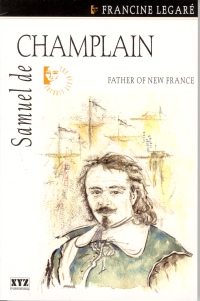| ________________
CM . . .
. Volume XI Number 2 . . . . September 17, 2004
excerpt:
Henry Ford said, "history is more or less bunk." Others consider it dull. In the hands of Francine Legaré, the history of Samuel de Champlain is neither. It is fun. Establishing a colony in New France, while incredibly difficult, was exciting. A sense of excitement and adventure fills the pages of Legaré's well-researched and thorough account of Canada's founder. Legaré studied journalism and has written a number of books for the government of Quebec. Originally written in French, Samuel de Champlain was translated into English by Jonathan Kaplansky, a translator who lives in Ottawa. The book is part of a series on prominent Canadians from all walks of life. Champlain is one of the most heroic figures in Canadian history. His many voyages to the "new world" and explorations in North America were of epic proportions. This becomes evident in Legaré's book when one sees the drawing of the type of ship in which Champlain crossed the Atlantic. It is also evident in her descriptions of his adventures in North America, which must have been just as arduous as the ocean crossings. Travelling by canoe over vast distances through unknown territory would be difficult for anyone. Champlain, however, found his adventures invigorating, the hardships minor, the rewards great. Without his persistence, a French colony in North America may never have taken root. Samuel de Champlain contains a bibliography and an index, and it is illustrated throughout with black and white drawings and maps of the period and photos. These illustrations are practical and amplify the feeling of history created by the text. There is also a chronology at the end of the book. Produced by Michele Venasse, this chronology highlights both Champlain's life and the world events that paralleled his career. These features help to make the book a valuable text. It could, of course, be read by any young person interested in Canadian history. Each chapter begins and ends with a selection from Champlain's journals. These excerpts convey the sense of awe Champlain felt whenever he witnessed something new and different. This feeling is continued in the text. The description of the torture and death of a captured Iroquois is no exception. It shows both Champlain's disgust and his amazement at one of the brutal realities of life in 17th century North America. He never overcame his disgust at such brutality even though he assisted his native allies, the Montagnais, in their struggles with the Iroquois and witnessed considerable torture and bloodshed at their hands. Much of Samuel de Champlain reads like a novel. Legaré has created dialogues that might have taken place between Champlain and his associates. This makes the book easy to read and very realistic. While dialogue may be unusual in history books, it will help to show young readers that historical figures were not just names from the past but people with thoughts and feelings much like themselves. Recommended. A retired college teacher, Thomas F. Chambers lives in North Bay, ON.
To comment
on this title or this review, send mail to cm@umanitoba.ca.
Copyright © the Manitoba Library Association. Reproduction for personal
use is permitted only if this copyright notice is maintained. Any
other reproduction is prohibited without permission.
NEXT REVIEW |TABLE OF CONTENTS FOR THIS ISSUE
- September 17, 2004.
AUTHORS
| TITLES | MEDIA REVIEWS
| PROFILES
| BACK ISSUES
| SEARCH | CMARCHIVE
| HOME |
